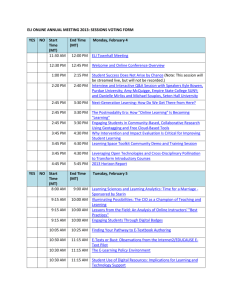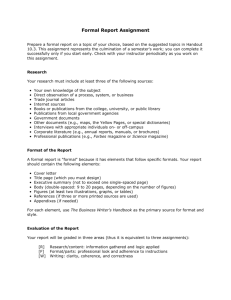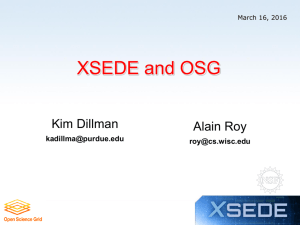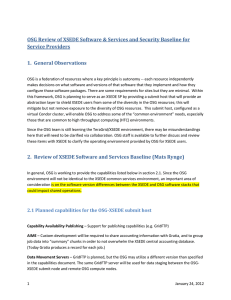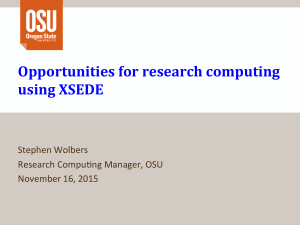Data Science Rearch and Education at Digital Science Center@SOIC
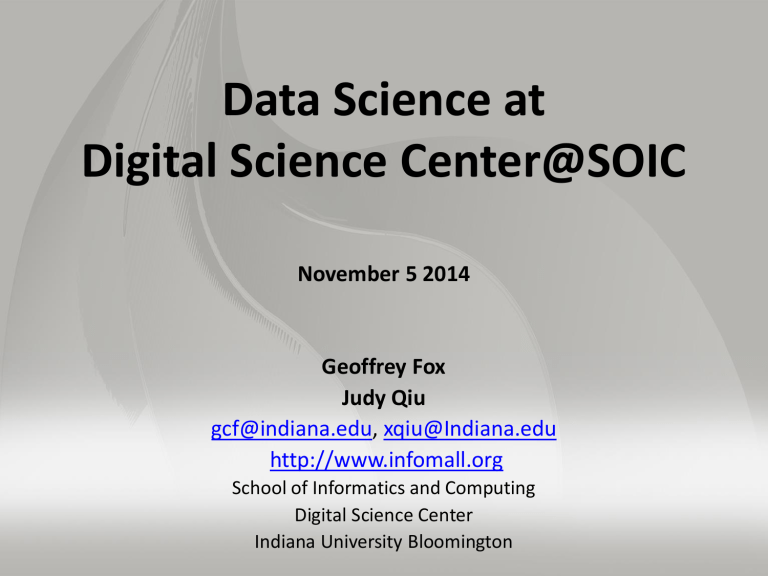
Data Science at
Digital Science Center@SOIC
November 5 2014
Geoffrey Fox
Judy Qiu gcf@indiana.edu
, xqiu@Indiana.edu
http://www.infomall.org
School of Informatics and Computing
Digital Science Center
Indiana University Bloomington
Digital Science Center Leadership
• Indiana University Faculty
• Geoffrey Fox, David Crandall, Judy Qiu, Gregor von Laszewski
Data Science Center Research Areas
• Digital Science Center Facilities
• RaPyDLI Deep Learning Environment
• HPC-ABDS and Cloud DIKW Big Data Environments
• Java Grande Runtime
• CloudIOT Internet of Things Environment
• SPIDAL Scalable Data Analytics Library
• Big Data Ogres Classification and Benchmarks
• Cloudmesh Cloud and Bare metal Automation
• Data Science Education with MOOC’s
DSC Computing Systems
• Working with SDSC on NSF XSEDE Comet System (Haswell)
• Adding 64-128 node Haswell based system (Juliet)
– 128-256 GB memory per node
– Substantial conventional disk per node (8TB) plus PCI based SSD
– Infiniband with SR-IOV
• Older machines
– India (128 nodes, 1024 cores), Bravo (16 nodes, 128 cores),
Delta(16 nodes, 192 cores), Echo(16 nodes, 192 cores), Tempest
(32 nodes, 768 cores) with large memory, large disk and GPU
– Cray XT5m with 672 cores
• Optimized for Cloud research and Large scale Data analytics exploring storage models, algorithms
• Bare-metal v. Openstack virtual clusters
• Extensively used in Education
NSF Data Science Project I
• 3 yr. XPS: FULL: DSD: Collaborative Research: Rapid Prototyping HPC
Environment for Deep Learning IU, Tennessee (Dongarra), Stanford
(Ng)
• “Rapid Python Deep Learning Infrastructure” (RaPyDLI) Builds optimized Multicore/GPU/Xeon Phi kernels (best exascale dataflow) with Python front end for general deep learning problems with
ImageNet exemplar. Leverage Caffe from UCB.
Large neural networks combined with large datasets (typically imagery, video, audio, or text) are increasingly the top performers in benchmark tasks for vision, speech, and Natural
Language Processing. Training often requires customization of the neural network architecture, learning criteria, and dataset pre-processing.
Classified
OUT
IN
NSF Data Science Project II
• 5 yr. Datanet: CIF21 DIBBs: Middleware and High
Performance Analytics Libraries for Scalable Data Science
IU, Rutgers (Jha), Virginia Tech (Marathe), Kansas (Paden), Stony
Brook (Wang), Arizona State(Beckstein), Utah(Cheatham)
• HPC-ABDS: Cloud-HPC interoperable software performance of HPC (High Performance Computing) and the rich functionality of the commodity Apache Big Data
Stack.
• SPIDAL (Scalable Parallel Interoperable Data Analytics
Library): Scalable Analytics for Biomolecular Simulations,
Network and Computational Social Science, Epidemiology,
Computer Vision, Spatial Geographical Information
Systems, Remote Sensing for Polar Science and Pathology
Informatics.
Big Data Software Model
Harp Plug-in to Hadoop
Make ABDS high performance – do not replace it!
Application
Framework
Resource
Manager
MapReduce
Applications
Map-Collective or Map-
Communication
Applications
MapReduce V2
Harp
YARN
1.20
1.00
0.80
0.60
0.40
0.20
0.00
0 20
100K points
40 60 80
Number of Nodes
200K points
100 120
300K points
140
Work of Judy Qiu and Bingjing Zhang.
Left diagram shows architecture of Harp Hadoop Plug-in that adds high performance communication, Iteration (caching) and support for rich data abstractions including key-value
Right side shows efficiency for 16 to 128 nodes (each 32 cores) on WDA-SMACOF dimension reduction dominated by conjugate gradient
Sequential
Parallel
Tweet
Clustering with Storm
Judy Qiu and Xiaoming Gao
Storm Bolts coordinated by
ActiveMQ to synchronize parallel cluster center updates
Speedup on up to 96 bolts on two clusters Moe and Madrid
Red curve is old algorithm; green and blue new
Java Grande and C# on 40K point DAPWC Clustering
Very sensitive to threads v MPI
C# Hardware 0.7 performance Java Hardware
64 Way parallel
128 Way parallel
C#
Java
256 Way parallel
TXP
Nodes
Total
Cloud DIKW based on HPC-ABDS to integrate streaming and batch Big Data
Raw
Data
Storm
Pub-Sub
Data
System Orchestration / Dataflow / Workflow
Archival Storage – NOSQL like Hbase
Batch Processing (Iterative MapReduce)
Information Knowledge Wisdom
Streaming Processing (Iterative MapReduce)
Storm Storm Storm Storm
Decisions
Storm
Internet of Things (Smart Grid)
IOTCloud
• Device Pub-Sub Storm
Datastore Data Analysis
• Apache Storm provides scalable distributed system for processing data streams coming from devices in real time.
• For example Storm layer can decide to store the data in cloud storage for further analysis or to send control data back to the devices
• Evaluating Pub-Sub Systems
ActiveMQ, RabbitMQ, Kafka,
Kestrel
Turtlebot and Kinect
Kafka Latency
RabbitMQ Latency
RabbitMQ outperforms
Kafka with
Storm
Big Data Ogres and their Facets
• 51 Big Data use cases: http://bigdatawg.nist.gov/usecases.php
• Ogres classify Big Data Applications with facets and benchmarks
• Facets I: Features identified from 51 use cases: PP(26), MR(18), MR-
Statistics(7), MR-Iterative(23), Graph(9), Fusion(11), Streaming/DDDAS(41),
Classify(30), Search/Query(12), Collaborative Filtering(4), LML(36), GML(23),
Workflow(51), GIS(16), HPC(5), Agents(2)
– MR MapReduce; L/GML Local/Global Machine Learning
• Facets II: Some broad features familiar from past like
– BSP (Bulk Synchronous Processing) or not?
– SPMD (Single Program Multiple Data) or not?
– Iterative or not?
– Regular or Irregular ?
– Static or dynamic ?,
– communication/compute and I-O/compute ratios
– Data abstraction (array, key-value, pixels, graph…)
• Facets III: Data Processing Architectures
14
Core Analytics Facet I
• Map-Only
• Pleasingly parallel - Local Machine Learning LML
• MapReduce:
• Search/Query/Index
• Summarizing statistics as in LHC Data analysis (histograms)
Recommender Systems (Collaborative Filtering)
• Linear Classifiers (Bayes, Random Forests)
• Alignment and Streaming Genomic Alignment, Incremental
Classifiers
• Global Analytics: Nonlinear Solvers (structure depends on objective function)
– Stochastic Gradient Descent SGD and approximations to Newton’s
Method
– Levenberg-Marquardt solver
Core Analytics Facet II
• Global Analytics: Map-Collective (See Mahout, MLlib)
Often use matrix-matrix,-vector operations, solvers (conjugate gradient)
• Clustering (many methods), Mixture Models, LDA (Latent Dirichlet Allocation),
PLSI (Probabilistic Latent Semantic Indexing)
• SVM and Logistic Regression
• Outlier Detection (several approaches)
• PageRank, (find leading eigenvector of sparse matrix)
• SVD (Singular Value Decomposition)
• MDS (Multidimensional Scaling)
• Learning Neural Networks (Deep Learning)
• Hidden Markov Models
• Graph Analytics (Global Analytics subset)
• Graph Structure and Graph Simulation
• Communities, subgraphs/motifs, diameter, maximal cliques, connected components, Betweenness centrality, shortest path
• Linear/Quadratic Programming , Combinatorial Optimization,
Branch and Bound
16
Protein Universe Browser for COG Sequences with a few illustrative biologically identified clusters
17
3D Phylogenetric Tree from WDA SMACOF
LC-MS Proteomics Mass Spectrometry
The brownish triangles are peaks outside any cluster.
The colored hexagons are peaks inside clusters with the white hexagons being determined cluster center
Fragment of 30,000 Clusters
241605 Points
19
Cloudmesh Software Defined System Toolkit
• Cloudmesh Open source http://cloudmesh.github.io/ supporting
– The ability to federate a number of resources from academia and industry. This includes existing FutureSystems infrastructure , Amazon Web Services, Azure,
HP Cloud, Karlsruhe using several IaaS frameworks
– IPython-based workflow as an interoperable onramp
Supports reproducible computing environments
Uses internally
Libcloud and
Cobbler
Celery Task/Query manager (AMQP -
RabbitMQ)
MongoDB
Scientific Impact of High End Resources
(XSEDE TAS)
• Is there some way to provide an indication about the impact of providing such facilities?
• Using EXTENSIVE Bibliometric data as criteria as mashup
• Sources: NSF, ISI Web of Science, (Google), XSEDE
• 140K publications, 20K XSEDE users, ~5K externally verified publications, 2M related publication database
• Metrics
• Number of Publications, citations, projects, users, researchers
• H-index, G-Index, I-index, …
• Correlation to externally vetted data, journal impact , …
• Unique data set to conduct extensive analysis.
• Previous effort only analyzed about 1% of the data
• We are not aware of similar comprehensive efforts.
Gregor von Laszewski
Fugang Wang
• Portal
• Users can look up their own data
• Generally useable and can be adapted this for your resources, department, ….
IU TAS
Interface
Layer
IU TAS
Publications
Mashup
IU TAS Architecture
REST API
IU TAS
Service
Layer
Portal
IU TAS
Publication
Mashup
IU TAS REST Services
NSF Award
DB Mining
3 rd Party
Queries
XSEDE
Portal
XD Entities
Mashup
IU NSF Awards
Publication data for XSEDE Users
UB TAS Databases &Reports
XDMoD
Warehous
XDcDB
Mirror
Publications &
Accounts
XSEDE Databases
XSEDE
Quarterly
Reports
POPS
Proposal
Data
NSF Database
NSF Awards
Original
Data Source
3 rd Party Data
Microsoft Academic
Search
Google Scholar
(User profiles)
ISI Web of Science
Citeseer, PUBMed,
ACM, IEEE, …
Mendeley
50
Comparing XSEDE Supported Publications with Peers
Top 1Q (%)
2Q(%)
3Q(%)
4Q(%)
25
0
BIOPHYSICAL
JOURNAL
JOURNAL OF
PHYSICAL
CHEMISTRY B
ASTROPHYSICAL
JOURNAL
JOURNAL OF
CHEMICAL
PHYSICS
JOURNAL OF THE
AMERICAN
CHEMICAL
SOCIETY
JOURNAL OF
CHEMICAL
THEORY AND
COMPUTATION
PHYSICAL REVIEW
D
PHYSICAL REVIEW
LETTERS
PHYSICAL REVIEW
B
MONTHLY
NOTICES OF THE
ROYAL
ASTRONOMICAL
SOCIETY
TOP 10 Overall
• ~ 1500 XSEDE supported publications appeared in these top 10 journals (by # of XSEDE supported publications published)
• Comparing each single publication with all peers appeared in the same issue. Get percentile ranking based on citation data (per ISI Web of Science data).
• Percentage of how many belongs to each quarter (top 25% to bottom 25%).
• In general trends towards higher quarter.
• Differences among fields (Physics, Astrophysics, Astronomical; Chemistry; etc.)
1
Data Science Definition from NIST Public Working Group
• Data Science is the extraction of actionable knowledge directly from data through a process of discovery, hypothesis, and analytical hypothesis analysis.
• A Data Scientist is a practitioner who has sufficient knowledge of the overlapping regimes of expertise in business needs, domain knowledge, analytical skills and programming expertise to manage the end-to-end scientific method process through each stage in the big data lifecycle.
See Big Data Definitions in http://bigdatawg.nist.gov/V1_output_docs.php
25
IU Data Science Program
• Program managed by cross disciplinary Faculty in Data
Science. Currently Statistics and Informatics and
Computing School (31 faculty) but will expand scope to full campus
• A purely online 4-course Certificate in Data Science has been running since January 2014 (with 70 students total in 2 semesters)
– 4 students will get certificate end of this semester
– Most students are professionals taking courses in “free time”
• A campus wide Ph.D. Minor in Data Science has been proposed.
• Courses labelled as “Decision-maker” and “Technical” paths where McKinsey says an order of magnitude more (1.5 million by 2018) unmet job openings in
Decision-maker track
McKinsey Institute on Big Data Jobs
• There will be a shortage of talent necessary for organizations to take advantage of big data. By 2018, the United States alone could face a shortage of 140,000 to 190,000 people with deep analytical skills as well as
1.5 million managers and analysts with the know-how to use the analysis of big data to make effective decisions.
• Decision Maker Path aimed at 1.5 million jobs. Technical Path covers the
140,000 to 190,000 http://www.mckinsey.com/mgi/publications/big_data/index.asp.
27
IU Data Science Program: Masters
• Masters Fully approved by University and State
October 14 2014 and starts January 2015
• Blended online and residential (any combination)
– Online offered at in-state rates (~$1100 per course)
• Informatics, Computer Science, Information and
Library Science in School of Informatics and
Computing and the Department of Statistics, College
of Arts and Science, IUB
• 30 credits (10 conventional courses)
• Basic (general) Masters degree plus tracks
– Currently only track is “Computational and Analytic Data
Science ”
– Other tracks expected such as Biomedical Data Science
Background on MOOC’s
• MOOC’s are a “disruptive force” in the educational environment
– Coursera, Udacity, Khan Academy and many others
• MOOC’s have courses and technologies
• Google Course Builder and OpenEdX are open source MOOC technologies
• Blackboard, Canvas and others are learning management systems with (some) MOOC support
• The MOOC version of Fox’s Big Data Applications and Analytics course has ~2000 students enrolled.
• Coursera Offerings have much larger enrollment
29
http://x-informatics.appspot.com/course
Example
Course Builder
MOOC
4 levels
Course
Section (12)
Units(29)
Lessons(~150)
Units are ~ traditional lecture
Lessons are ~10 minute segments
31
Example
Course Builder
MOOC
The Physics
Section expands to 4 units and 2
Homeworks
Unit 9 expands to 5 lessons
Lessons played on Youtube
“talking head video +
PowerPoint”
The community group for one of classes and one forum (“No more malls”)
33
Office
Mix Site
Lectures
Made as ~15 minute lessons linked here
Metadata on
Microsoft Site
34
Potpourri of Online Technologies
• Canvas (Indiana University Default): Best for interface with IU grading and records
• Google Course Builder: Best for management and integration of components
• Ad hoc web pages: alternative easy to build integration
• Mix: Simplest faculty preparation interface
• Adobe Presenter/Camtasia: More powerful video preparation that support subtitles but not clearly needed
• Google Community: Good social interaction support
• YouTube: Best user interface for videos
• Hangout: Best for instructor-students online interactions (one instructor to 9 students with live feed). Hangout on air mixes live and streaming (30 second delay from archived YouTube) and more participants
35
